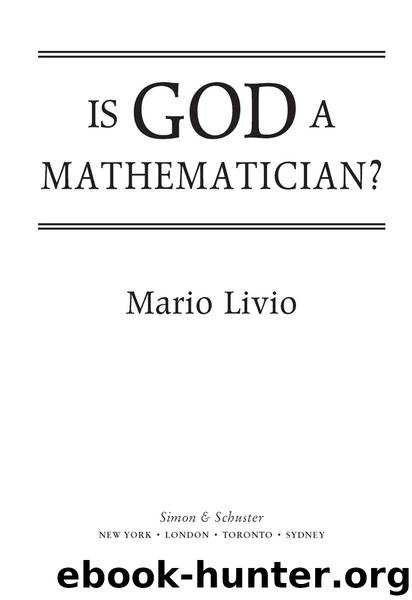Is God a Mathematician? by Mario Livio

Author:Mario Livio
Language: eng
Format: mobi, epub, azw3
Publisher: Simon and Schuster
Published: 2009-01-06T10:00:00+00:00
CHAPTER 6
GEOMETERS: FUTURE SHOCK
In his famous book Future Shock, author Alvin Toffler defined the term in the title as “the shattering stress and disorientation that we induce in individuals by subjecting them to too much change in too short a time.” In the nineteenth century, mathematicians, scientists, and philosophers experienced precisely such a shock. In fact, the millennia-old belief that mathematics offers eternal and immutable truths was crushed. This unexpected intellectual upheaval was caused by the emergence of new types of geometries, now known as non-Euclidean geometries. Even though most nonspecialists may have never even heard of non-Euclidean geometries, the magnitude of the revolution in thought introduced by these new branches of mathematics has been likened by some to that inaugurated by the Darwinian theory of evolution.
To fully appreciate the nature of this sweeping change in worldview, we have first to briefly probe the historical-mathematical backdrop.
Euclidean “Truth”
Until the beginning of the nineteenth century, if there was one branch of knowledge that had been regarded as the apotheosis of truth and certainty, it was Euclidean geometry, the traditional geometry we learn in school. Not surprisingly, therefore, the great Dutch Jewish philosopher Baruch Spinoza (1632–77) entitled his bold attempt to unify science, religion, ethics, and reason Ethics, Demonstrated in Geometrical Order. Moreover, in spite of the clear distinction between the ideal, Platonic world of mathematical forms and physical reality, most scientists regarded the objects of Euclidean geometry simply as the distilled abstractions of their real, physical counterparts. Even staunch empiricists such as David Hume (1711–76), who insisted that the very foundations of science were far less certain than anyone had ever suspected, concluded that Euclidean geometry was as solid as the Rock of Gibraltar. In An Enquiry Concerning Human Understanding, Hume identified “truths” of two types:
All the objects of human reason or enquiry may naturally be divided into two kinds, to wit, Relations of Ideas, and Matters of Fact. Of the first kind are…every affirmation which is either intuitively or demonstratively certain…Propositions of this kind are discoverable by the mere operation of thought, without dependence on what is anywhere existent in the universe. Though there never were a circle or triangle in nature, the truths demonstrated by Euclid would forever retain their certainty and evidence. Matters of fact…are not ascertained in the same manner; nor is our evidence of their truth, however great, of a like nature with the foregoing. The contrary of every matter of fact is still possible; because it can never imply a contradiction…That the sun will not rise tomorrow is no less intelligible a proposition, and implies no more contradiction than the affirmation, that it will rise. We should in vain, therefore, attempt to demonstrate its falsehood.
In other words, while Hume, like all empiricists, maintained that all knowledge stems from observation, geometry and its “truths” continued to enjoy a privileged status.
The preeminent German philosopher Immanuel Kant (1724–1804) did not always agree with Hume, but he also exalted Euclidean geometry to a status of absolute certainty and unquestionable validity.
Download
Is God a Mathematician? by Mario Livio.epub
Is God a Mathematician? by Mario Livio.azw3
This site does not store any files on its server. We only index and link to content provided by other sites. Please contact the content providers to delete copyright contents if any and email us, we'll remove relevant links or contents immediately.
| Applied | Geometry & Topology |
| History | Infinity |
| Mathematical Analysis | Matrices |
| Number Systems | Popular & Elementary |
| Pure Mathematics | Reference |
| Research | Study & Teaching |
| Transformations | Trigonometry |
Modelling of Convective Heat and Mass Transfer in Rotating Flows by Igor V. Shevchuk(6391)
Weapons of Math Destruction by Cathy O'Neil(6147)
Factfulness: Ten Reasons We're Wrong About the World – and Why Things Are Better Than You Think by Hans Rosling(4694)
Descartes' Error by Antonio Damasio(3230)
A Mind For Numbers: How to Excel at Math and Science (Even If You Flunked Algebra) by Barbara Oakley(3221)
Factfulness_Ten Reasons We're Wrong About the World_and Why Things Are Better Than You Think by Hans Rosling(3199)
TCP IP by Todd Lammle(3134)
Fooled by Randomness: The Hidden Role of Chance in Life and in the Markets by Nassim Nicholas Taleb(3045)
Applied Predictive Modeling by Max Kuhn & Kjell Johnson(3018)
The Tyranny of Metrics by Jerry Z. Muller(3003)
The Book of Numbers by Peter Bentley(2912)
The Great Unknown by Marcus du Sautoy(2648)
Once Upon an Algorithm by Martin Erwig(2599)
Easy Algebra Step-by-Step by Sandra Luna McCune(2585)
Lady Luck by Kristen Ashley(2534)
Practical Guide To Principal Component Methods in R (Multivariate Analysis Book 2) by Alboukadel Kassambara(2497)
Police Exams Prep 2018-2019 by Kaplan Test Prep(2487)
All Things Reconsidered by Bill Thompson III(2357)
Linear Time-Invariant Systems, Behaviors and Modules by Ulrich Oberst & Martin Scheicher & Ingrid Scheicher(2334)
